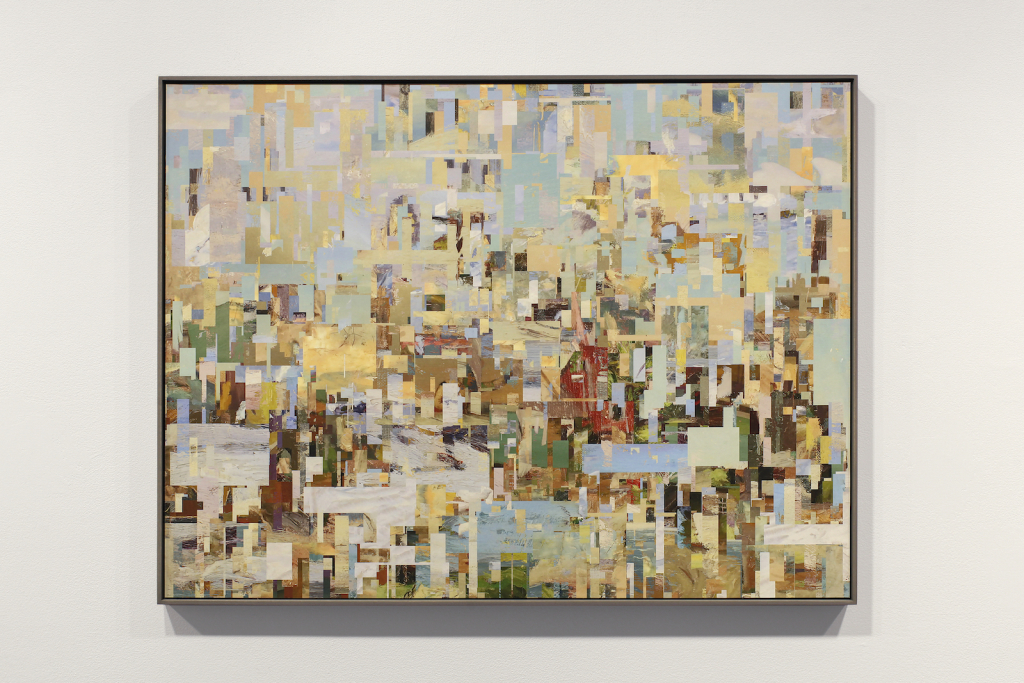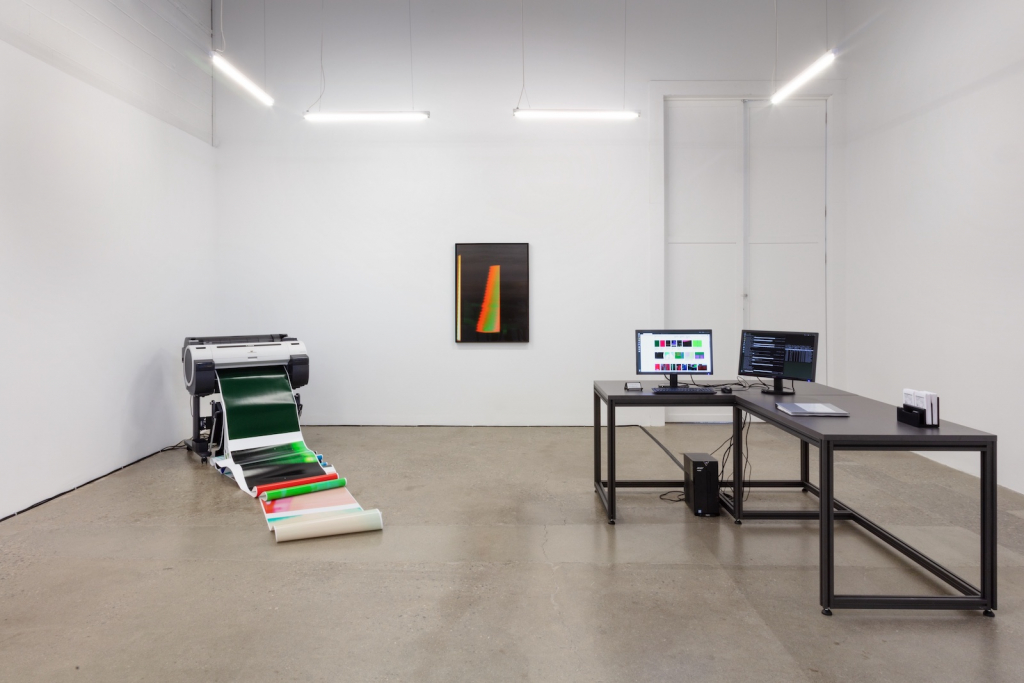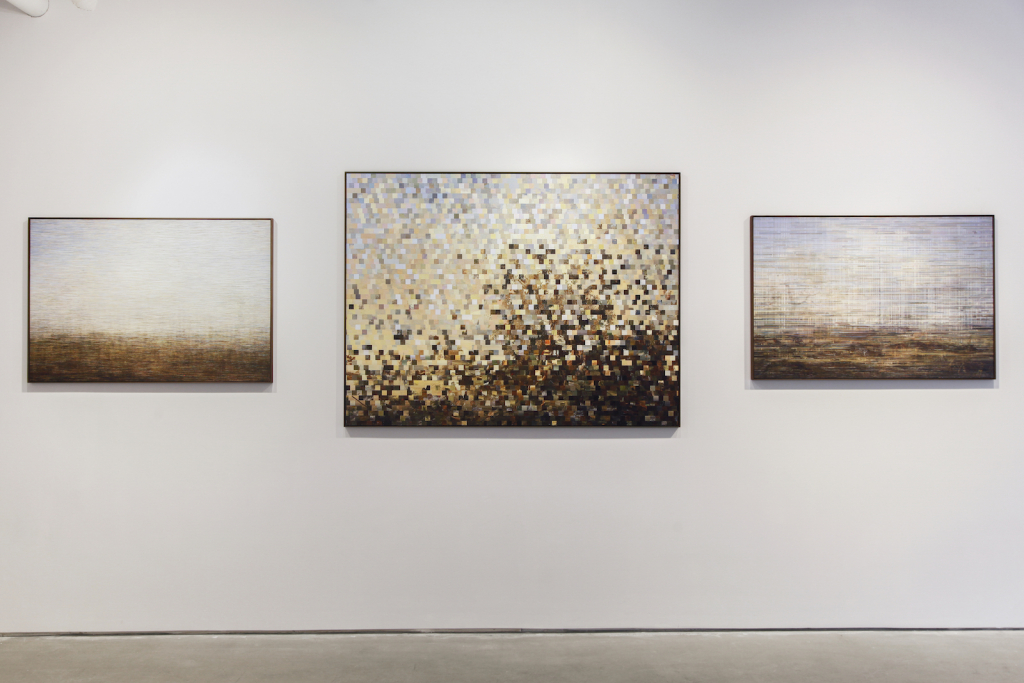Landscape Past Future: An interview with Adam Basanta
As artificial intelligence rapidly becomes omnipresent in our daily lives—from predictive writing to self-driving cars—it is only natural that an increasing number of artists have started to explore both the potential and the limitations of these tools. In this interview with Montreal-based artist Adam Basanta, we discuss artificial intelligence and the ambiguous notion of authorship in a fully automated era.
Daphné Boxer In your exhibition recently on view at Ellephant gallery, Landscape Past Future – A Brief History of Cultural Production Part 1, a series of “digital print landscapes” were made by sampling databases of canonized historical works through trained algorithms and machine learning programs. For this series, you used datasets from 17th century Dutch painting, 19th century American landscape photography and 20th century Canadian landscape painting. Correct me if I’m wrong, but that represents quite a distinct shift from your previous work, which mostly focused on sound, performance and installation? Could you tell me what drew you to this new format?
Adam Basanta In some ways I see it is as a distinct shift but in others I see a continuous development––maybe it’s too early for me to tell! Since my background and studies were primarily in the field of experimental music, the use of sound and kinetic movement in gallery contexts was very natural for me because these are performative approaches in which events unfold in time, similarly to music. As I make more work in gallery contexts, I have become more comfortable with taking forms or mediums that I have absolutely no previous training in, and trying to interpret them differently through my viewpoint or skill-set. This often involves having to somehow invent a way for me to work with these mediums, which was the case for this project.
Once the algorithms are trained through machine learning programs, do you let the program create the artwork or do you intervene in the process? Could you give me some examples of your artistic input during the creation of the work?
A. B. In Landscape Past Future, I was making a conscious effort to use machine learning algorithms as tools for specific tasks rather than as an overriding technique. I think that’s why the images look different from many other projects, which feed databases into a GAN (generative adversarial network) and generate output, a process that ends up having a very particular aesthetic. I hope as the field progresses, we will see more individual approaches in applying these techniques, and that the results will become more varied, as a function of artistic intent rather than computational reality.
One of the most time-consuming elements in creating the images in the exhibition was finding interesting and appropriate relationships between the contents of the database and the way they are re-organized using the mosaic technique. There is no algorithm to tell me how to do this. There was a lot of trial and error in this process, and a lot of thinking about what the sources are and how I can use them in a way that reflects something of the immaterial context in which they were created.
For instance, in the Dutch series, the paintings come from an early industrialized society and a sense of increasing command over nature, but also a sense of romanticism towards nature. The mosaic techniques I used for these prints are at times very organized, grid-like or rectilinear, preserving a very particular vantage point that is iconic of 17th century Dutch landscape painting, while at other times resemble pointillistic pencil strokes that almost seem hand-made. This is in contrast to the Canadian suite, which uses early 20th century Canadian landscape paintings, a very different context of creation, and very different artistic techniques: bold colors and heavy brush strokes, realism is no longer as paramount as capturing some of the underlying spirit of a wild and grand nature. For this series, I used very irregular mosaic styles, almost closer to collage, to retain some of these big brush strokes, and a lot of overlapping pixel regions to suggest a more spontaneous sort of construction.
The series is created from a large database of public museum collections, such as the Rijksmuseum, the Louvre, the Metropolitan Museum, the Prado Museum and the Tate Modern. Could you tell me more about their origins and what specifically interested you about their content?
A. B. With this project, I was initially dealing with such large numbers of images from institutional collections that when you combine them you basically get a form of statistical noise. The decision to narrow them down to landscape paintings was both thematic and practical, and machine learning techniques were a useful and fitting approach. Thematically, the environmental crisis and increasing public discourse surrounding artificial intelligence seemed like a potent combination in 2019. The narrower dataset of landscape paintings embodies a romantic attitude towards nature that developed in early industrial society and is still present in an era of posting natural landscapes to an Instagram feed organized by algorithms.
From a practical point of view, using these defined forms of landscape painting—“schools” in which there are fairly consolidated rules and a high degree of craft—becomes an interesting dataset to work with, one in which the homogeneity and heterogeneity of features are balanced. When combining or mosaicking this kind of dataset, it is possible to get a nearly statistical sense of the genre, while also seeing particular details of specific works.
Iconic, historical artworks become the raw material for your work. Is this a way for you to challenge the idea of authorship? How do you justify your process and is it important for you to be transparent about your sources?
A. B. I suppose so, although it’s never something I set out to do explicitly. I just find the act of authoring itself to be interesting and problematic, in the sense that I cannot understand completely how I author my own work. So I suppose these uncertainties about authorship seep into the mechanics of the work itself.
In Landscape Past Future, I am trying to integrate the original landscape paintings and photographs into the fabric of the new; the identity of the works, their provenance, and what they stand for, is a crucial aspect of the project. For this reason, I produced a limited-edition book (in collaboration with Montreal-based art publisher Anteism Books), which acts almost as an academic “works-cited” list or bibliography. In the book, each painting is shown alongside a list of all the artworks that have been mosaicked in it. This list is accurate to the pixel, which I joke can in theory function as a recipe: take 537,400 pixels of this painting, add 100,000 of that painting, and voilà…
The detailed nature of this list also raises other questions about authorship and copyright, like whether infringement can be determined using quantitative measures. This is a question we need to grapple with because copyright infringement complaints (for instance, on Youtube) are increasingly automated and carried out using algorithms. So, by listing the exact pixels of each source, I am trying to raise a ridiculous question: how many pixels constitutes copying? How many copyrighted pixels constitute infringement? 100? 100,000? 15% of the image surface? Does it matter if the copyright is held by the artist, or by the institution that owns the work?
Once these questions are raised, it becomes clear that claiming infringement based on a definitive number of pixels would be arbitrary, and that copyright infringement—while it can be aided by quantitative analysis—depends on a qualitative understanding of the underlying processes of a work.
There appears to be a lot of confusion around the term artificial intelligence. Would you say that the general public misunderstands or underestimates the human input necessary to make these systems function at the moment?
A. B. AI is a term I really dislike for a few reasons. It has become a catch-all phrase, and many of the things we call AI actually contain very little of what we would consider when we use the term “intelligence” in a general sense. Of course, the media reporting is also frustrating and sadly often repeats the marketing propaganda of companies with a vested interest in the success of AI.
With regard to reporting on art in particular, it seems that every 20 or 30 years, we need to resurrect the narrative of the death of the author or artist: maybe this points to an unconscious homicidal tendency we as a society have towards artists and authors! The notion that a technological development has (or could) replace artists also seems to me like a misreading of what constitutes technology in the first place. For instance, classical musical instruments are highly refined technological artifacts. Same for the myriad of technologies and material practices used in various painting and sculpting techniques. The camera did not replace the artist, electric guitars and samplers did not ruin music. It is normal to question the newest technology, and a healthy degree of skepticism towards it is certainly welcome, but in hindsight, we find that artists generally find new and imaginative ways to use such technology and push art practices forward as a whole. At the end of the day, it is not about the tool itself but how you use it.
I do find that there is an inherent irony in the use of Artificial Intelligence to make art, because I don’t feel like “intelligence”—as in the ability to acquire and apply knowledge and skills—is the most important element for making art. I think in some ways art is much more dependent on an underlying and insistent “stupidity.” And I mean “stupidity” in a positive sense, as a stubborn, at times brash and cheeky commitment to making something that is in opposition to utilitarian logic; making something that embodies, in terms of both process and final result, a rejection of normative adjudication of economic value. So, I suspect that, on its own, modelling intelligence computationally is not necessarily an effective process for making ground-breaking art. Perhaps, after the initial novelty, it’s not even enough to make interesting art.
Of course, AI and machine learning offer new possibilities, and from a technical point of view can be seen as a paradigm shift. But in terms of their use in art, I see them as falling into a long line of procedural approaches to making art. I wish this was explored more in the discourse surrounding artistic production using computational techniques.
At the end of the day, I don’t see AI challenging authorship in a way that is substantively different than what would occur with a collage artist. I don’t see AI challenging human input any more than any artist who has used analog chance operations to guide their work. I don’t even see collaborating with an algorithm as substantively different than collaborating with a lump of clay (the properties of which could be represented algorithmically). There are differences in degree of course, but not of substance.
So, certainly, I feel the human component is still key—at least, it is key to making interesting work using AI. This is traditionally understood as a curatorial attitude towards the dataset, choosing the stuff that the machine learning algorithm will analyze, learn, and re-generate. But actually, it is the framing of the output, conceptually and practically, that is really key. Ultimately, the concept or framing of the work is something that needs to be done with full awareness of the micro and macro contexts around it. A machine learning system will always lag behind a human in this task because it’s always at least one step behind us in terms of input.
You recently got involved in a legal battle regarding your installation All We’d Ever Need Is One Another exhibited at the Digital Art Biennial in Montreal last year. Do you think the advancement in technology will bring us to reconsider new legislation regarding intellectual property, copyright and fair use in the near future?
A. B. I would hope so, but sadly I am not optimistic about this. The legal system is designed in a manner that, in practice, mostly protects the interests of those with the wealth to navigate it. There is a reason why I am being sued for analyzing an image from a website using an algorithm, but nobody would think to sue Google for the same supposed “infringement,” which they commit on a much larger scale. And, as is always the case, the legal mechanisms lag decades behind the technology.
That said, the legal case involving All We’d Ever Need Is One Another is still ongoing, and hopefully we will have a chance to make a small impact by creating a precedent in the law that protects an artist’s right to fair use in the context of massive online image databases and art made with algorithmic processes.
Using various mediums, Adam Basanta (b.1985, lives and works in Montreal, QC) explores technological practices as socially-mediated performances, distributed and intertwined throughout a variety of human, cultural, material and computational agencies. Since 2015, his work has been exhibited in galleries and art institutions worldwide and is featured in institutional and private collections. He has been awarded several prizes in Canada and abroad, including the Prix Pierre-Ayot 2018. As an active experimental composer and performer, his concert music, live performances, and sound recordings are presented at various venues around the world.
Daphné Boxer is an independent curator based in Canada. Her most recent research focuses on architecture and the impact of new technologies on the cultural landscape of urban environments. She is guided by an underlying curatorial interest in examining the legacies of spatial erasure in relation to contemporary notions of progress and related forms of political and cultural resistance. In 2016, she co-founded VIE D’ANGE with the curator Eli Kerr, an independent project space and residency program based in Montréal.








